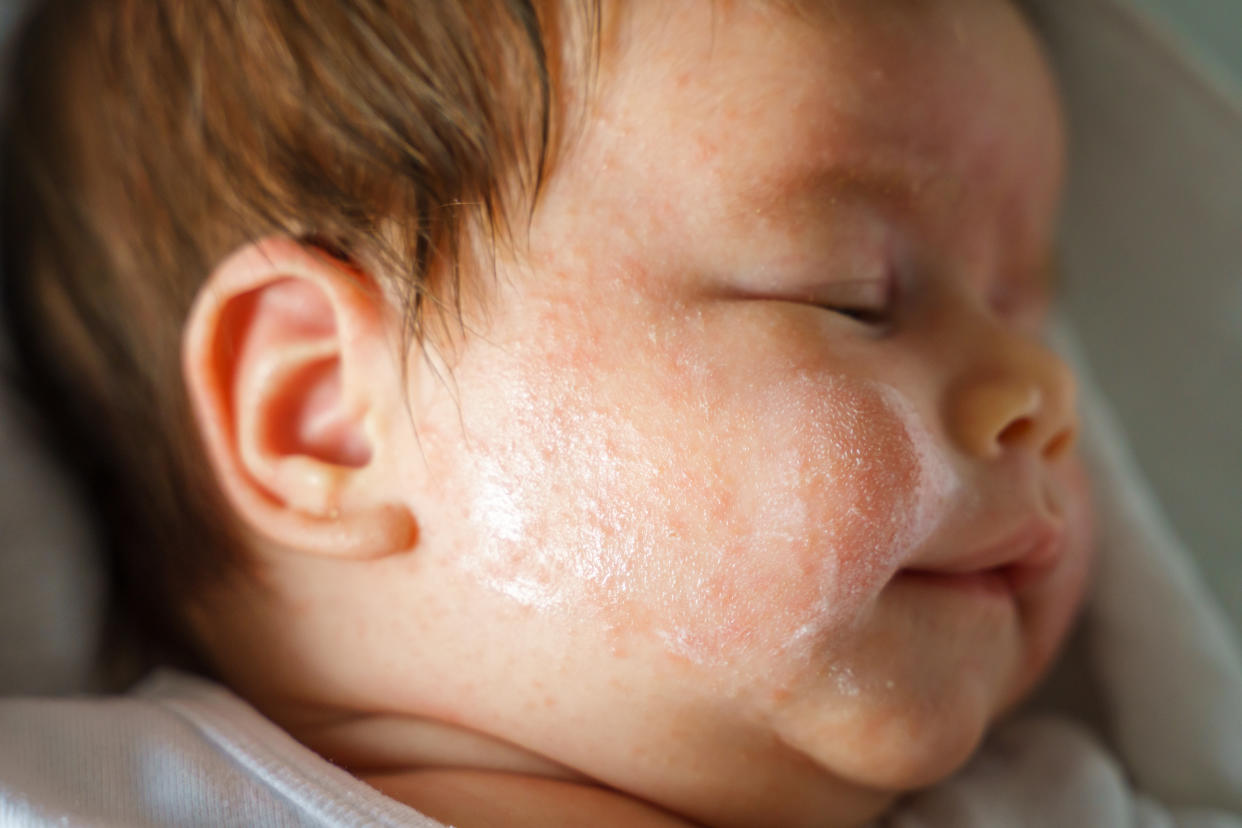Your baby's eczema may be a sign they'll develop asthma and allergies in later life

The sight of red, dry and itchy skin on your baby can be worrying for new parents, but eczema is a common occurrence in infants in their first six months. According to the National Eczema Society, eczema affects around 20% of children in the UK.
But some studies have found that the presence of eczema, also known as atopic dermatitis, in babies could be linked to the development of asthma and food allergies later in life. This is known as the “atopic march”.
One study, which examined children aged seven who had eczema as babies, found that 43% went on to develop asthma and 45% developed allergic rhinitis (hay fever). A separate study found that children who experienced more severe eczema as an infant had a 60% higher risk of developing asthma compared to children who had mild eczema.
Dr Sasha Dhoat, consultant dermatologist at Stratum Clinics, tells Yahoo UK that she has consistently observed the atopic march in her own clinical practice, and that about a third of babies with eczema are more likely to develop food allergies and associated respiratory disorders.
Eczema can lead to:
Skin inflammation
Intense itching
Interrupted sleep
Emotional distress
Risk of secondary skin infections
Growth impairment in some cases

Atopic march: What causes it?
While the progression of eczema to allergies and asthma is not linear nor predictable, Dr Dhoat explains the hypothesis that the skin condition causes “cracks” in babies’ immunity.
“It is helpful to think about the epidermis, the outer layer of skin, like a brick wall to the outside world. In individuals with eczema, the brick wall, or skin barrier, is impaired, dry and cracked and it is hypothesised this allows allergen penetration, sensitization and development of other allergic diseases, over time,” she says.
Dr Amer Khan of Harley Street Skin adds that genetics may also play a role in the development of conditions like food allergies, hay fever, and asthma. He points to genetic variations involves in the regulation of the immune system that have been linked to the atopic march.
“Genes associated with immune response, such as interleukins and Toll-like receptors, have been identified as potential contributors to the progression of allergic disease,” he says. “Understanding these genetic factors not only provides valuable insights into the disease mechanisms but also offers exciting possibilities for personalised treatments in the future.”

Environmental factors can also contribute to the progression from eczema to other allergies. “Allergens, pollutants, lifestyle choices, and early-life exposures can all influence the manifestation and severity of allergic diseases,” Dr Khan explains, calling for a “holistic approach” to effectively manage the atopic march.
“The first step in managing this condition involves early recognition and diagnosis. Healthcare providers, including dermatologists, allergists and paediatricians, play a vital role in identifying the various components of atopic march and tailoring a treatment plan to address each individual’s specific needs.”
Is the atopic march preventable?
Dr Dhoat says that, based on the evidence, it would appear that the maintenance and repair of the skin barrier in infants with eczema could potentially prevent the subsequent development of food allergies and asthma.
In addition, allergy testing can help identify triggers and allergens specific to individuals, which allows for targeted intervention, Dr Khan adds. “By identifying individuals at high risk based on their genetic profile, healthcare providers can intervene early, potentially reducing the burden of allergic diseases throughout their lives.”
He also urges for more education and support for individuals and their families to be better able to manage the atopic march. “Raising awareness about the condition, providing guidance on skincare routines, and offering psychological support can significantly improve the overall wellbeing of those affected.”
Watch: 1 in 4 people of colour with eczema feel ashamed
How do you treat eczema in babies?
Dr Dhoat advises that parents begin a skin care regime that includes moisturiser, soap substitutes and topical steroids if their baby develops eczema.
Apply moisturiser regularly
Apply a moisturiser, also known as an emollient, several times a day every day to the baby’s whole face and body. “The drier the skin, the more frequently moisturiser should be applied. I often recommend liberal application at every nappy change. The best moisturiser to use is the greasiest one you are prepared to apply,” Dr Dhoat says.
Use a soap substitute
A soap substitute means washing with a moisturiser instead of soap. Dr Dhoat advises parents to avoid products that have a “fragrance” or “bubble” when choosing a soap substitute. “Remember infants can be internally sensitised to allergens through their cracked, dry skin, so this includes avoiding ‘natural products’ such as essential oils and herbal tinctures.”
Apply topical steroids

Topical steroids, preferably in the form of ointments, can help relieve red, raised, cracked, and weepy areas of skin. “They come in different strengths and the doctor or specialist nurse will advise which type needs to be used, where and for how long. Use a fingertip unit to cover the same area of skin as two hands laid flat with the fingers together, or if visibly shiny, enough has been applied.
More information about skin conditions:
Toddler with eczema so bad liquid was 'pouring from his face' receives life-changing treatment (Yahoo Life UK, 3-min read)
Mandy Moore on battling eczema: ‘I had to find some semblance of relief’ (Motherly, 4-min read)
Google says ‘Lens’ can now search for skin conditions based on images. Here’s how (The Independent, 2-min read)


